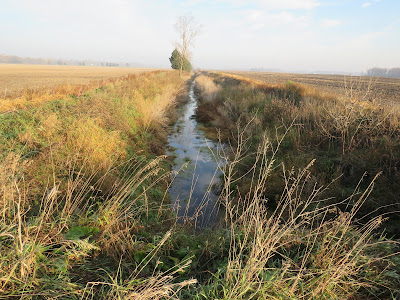I’m at Mt Pleasant’s Chipp-a-Waters Park on a mostly sunny morning with temperatures in the lower 30’s and a westerly breeze, watching the clear, cold water of the Chippewa River flow gently east through a snowy landscape. Up ahead, I watch a family of geese move with the current downstream. Following a paved pathway along the river’s edge, I spot a Cocklebur plant with its prickly seedheads and a Prickly rose plant with its large, bright-red, pear-like hips. Since these hips are fleshy and edible, I pick one and enjoyed its sweet flavor. While they are consumed by humans for jelly and tea, birds love them as well. On the other side of the trail on the snow-covered ground, I notice tracks of a Field mouse and a briefly resting Dark-eyed Junco. Juncos, like many other birds, migrate “South” for the winter months; however, lower Michigan is their south. These birds live in Canada for the rest of the year and come down here only in the winter where they can be seen around backyard bird feeders eating assorted grass, thistle, and sunflower seeds. When they are not at feeders, they can be found near farm fields foraging for grains on the ground that were not harvested. Scanning the understory, I’m not surprised to see dead leaves of American Beech and White Oak still attached to branches. However, I am surprised to see a solitary Maple tree with leaves still attached (a possible hybrid). Tree foliage that is still green include Buckthorn with its dark blue fruit and Winterberry with its bright red fruit. Crossing the Brandell bridge over the Chippewa River, I gaze west to take in the scenic riparian landscape. Circling the paved path around Viet’s Woods, I spot a female Hairy Woodpecker (males have a red patch on the back of the head) feeding on a snag and a perching male Goldfinch. Beginning in September, and continuing for six to eight weeks, these birds molt all their feathers, ending up with a completely new, drab-colored set as they head into the winter. In the spring, they grow new feathers that are a bright yellow breeding plumage (stock photo). Most Goldfinches observed around here do not migrate. To stay warm on a cold winter's night, these birds have been known to burrow under the snow to form a cozy sleeping cavity. They will also roost together in coniferous trees. Other sightings include Whitetail deer tracks and Fox Squirrel tracks. Back across the bridge heading toward the car, I notice a stand of leafless Black Locust trees with 4-inch seed pods hanging from their branches.
Hunter or hunted
Man or deer
Who’s the killer
Answer is clear
Heated blind
Comfortable wait
High-powered gun
Pile of bait
Shots ring out
Bullets stray
Whitetail runs
No death today
D. DeGraaf




